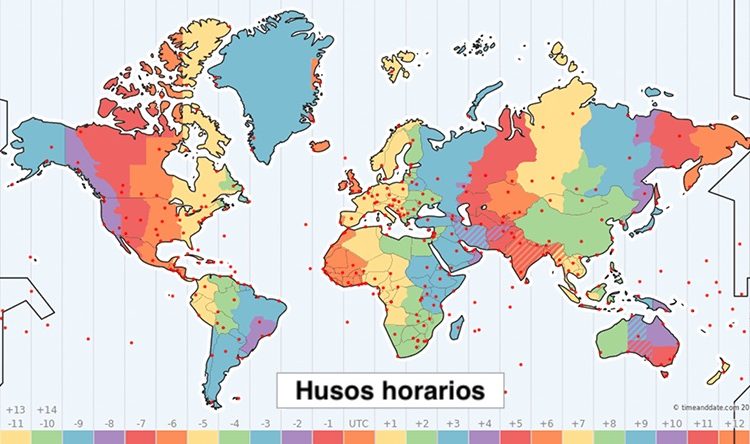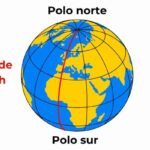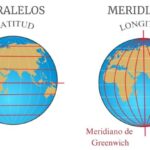We explain what time zones are and why they are necessary. Also, how they work and how they affect everyday life.

What are time zones?
The time zones are imaginary divisions of the earth's surface, each of which corresponds to a region where the same time is used. These regions are called “time zone” or “time zone” and have a specific time assigned, which applies to all populations whose geographical location shares the same meridian.
Thus, the planet Earth is divided into zones (which are strips or columns on the planisphere), and this division allows us to calculate the time in each country in the world by adding or subtracting an hour according to the number of time zones that separate us. his.
For example, if there are 3 time zones between Mexico and Argentina, this means that three hours will have to be added or subtracted from the time recorded by the clocks in one place to determine the time in the other.
Some very large nations have more than one time zone, such as the United States, Russia, Australia or Canada, since they are crossed by several meridians.
Characteristics of time zones
The time zones have the following characteristics:
- They determine the time difference between countries.
- There are 24 time zones in the world.
- They are organized according to Coordinated Universal Time (UTC).
- The time zone UTC 0 is in Greenwich, England.
- Each time zone is separated from the next by 15° longitude.
- There are countries that, due to their size, have more than one time zone.
How do time zones work?
The time zone system arises because the Earth rotates on its axis from west to east which causes the Sun to illuminate one part (the one that is during the day), while leaving the other in darkness (the one that is at night). Given the need to organize the time of all countries in the world, Coordinated Universal Time (UTC) was created.
The Greenwich meridian was selected as the zero reference point (0° longitude) during the International Meridian Conference in 1884. This meridian serves as the basis for establishing time in different countries: from this point on, the Earth is divided into 24 time zones and each one represents 15° of longitude, which is equivalent to one hour.
At the other end of the Greenwich meridian is the 180° meridian or Greenwich antimeridian. This is considered the international line of change of day, that is, the point at which, on clocks, the day ends and a new one begins.
Impact of time zones on daily life
The most longitudinally extended countries that manage more than one time zone in their territory must organize people's daily lives based on several different schedules. In the United States, for example, they operate a schedule for the states closest to the Atlantic Ocean and another for the states near the Pacific.
China represents the opposite example: it is a very large country that has a single time zone. For this reason, in areas very far from Beijing (the city that has the time corresponding to its meridian), the time is offset from sunrise and sunset. Thus, in some places in China the sun rises at four in the morning and it becomes night at four in the afternoon.
The places that are located on both sides of the Greenwich antimeridian have the peculiarity that they operate on the same schedule, but 24 hours apart.. This means that in one place it is three in the afternoon on one day and a very short distance from there it is three in the afternoon, but on the next day.
Related to this, Kiribati is the first country to appear east of the Greenwich antimeridian, making it the first place where the day begins and the first to celebrate the New Year. On the other hand, American Samoa, west of the day-change line, is the last country to pass the day and therefore the last to welcome the New Year.
Examples of time zones
Below is a list of time zones for some places in the world:
- UTC-12. Howland and Baker Islands (United States).
- UTC-11. American Samoa.
- UTC-10. Hawaii, French Polynesia, Cook Islands (New Zealand).
- UTC-9:30. Marquesas Islands (French Polynesia).
- UTC-9. Mainland Alaska, Gambier Islands (French Polynesia).
- UTC-8. Canada (west), United States (west), Mexico.
- UTC-7. Canada (central-west), United States (central-west), Mexico.
- UTC-6. Belize, Canada (central-east), Chile, Costa Rica, El Salvador, United States (central-east), Guatemala, Honduras, Mexico, Nicaragua.
- UTC-5. Bahamas, Brazil, Canada (east), Colombia, Cuba, Ecuador, United States (east), Haiti, Jamaica, Panama, Peru, Cayman Islands.
- UTC-4. Antigua and Barbuda, Barbados, Bolivia, Brazil, Canada, Dominican Republic, Dominica, Greenland, Grenada, Guyana, Netherlands Antilles, Paraguay, Puerto Rico, Trinidad and Tobago, Venezuela.
- UTC-3. Argentina, Brazil, French Guiana, Suriname, Uruguay.
- UTC-2. Brazil (coastal area), Sandwich Islands (United Kingdom).
- UTC-1. Greenland, Cape Verde, Azores Islands (Portugal).
- UTC 0. Burkina Faso, Ivory Coast, Canary Islands (Spain), Ghana, Ireland, Iceland, Liberia, Morocco, Portugal, United Kingdom, Senegal, Togo.
- UTC+1. Germany, Albania, Bosnia and Herzegovina, Belgium, Cameroon, Austria, Spain, Slovenia, Denmark, France, Hungary, Macedonia, Italy, Nigeria, Norway, Netherlands, Czech Republic, Vatican City, Tunisia, Switzerland, Sweden.
- UTC+2. Bulgaria, Botswana, Jordan, Israel, Finland, Egypt, Estonia, Palestine, Namibia, Libya, Rwanda, Romania, Syria, South Africa, Ukraine, Zimbabwe.
- UTC+3. Saudi Arabia, Belarus, Qatar, Ethiopia, Iraq, Kenya, Kuwait, Madagascar, Russia (west), South Sudan, Turkey, Yemen.
- UTC+3:30. Iran.
- UTC+4. Armenia, United Arab Emirates, Russia (central-west), Oman.
- UTC+4:30. Afghanistan.
- UTC+5. Kazakhstan, Pakistan, Maldives, Russia (central-east).
- UTC+5:30. India, Sri Lanka.
- UTC+5:45. Nepal.
- UTC+6. Bangladesh, Kyrgyzstan, Russia (Omsk only).
- UTC+6:30. Cocos Islands (Australia) and Burma.
- UTC+7. Cambodia, Indonesia, Laos, Mongolia, Russia, Thailand, Vietnam.
- UTC+8. Australia (west), Brunei, China, insular Indonesia, Malaysia, Philippines, Singapore.
- UTC+8:30. North Korea.
- UTC+9. South Korea, Japan, Palau, East Timor, Russia.
- UTC+9:30. Australia (center).
- UTC+10. Australia (east), Micronesia.
- UTC+11. Vanuatu, Papua New Guinea, Solomon Islands.
- UTC+12. Fiji, Nauru, New Zealand and Russia (far east).
- UTC+13. Tonga, Samoa.
- UTC+14. Kiribati.
References
- McKeever, A. (sf). Curiosities (and craziness) about the world's time zones. National Geographic. https://www.nationalgeographic.es/
- Galileo Galilei Planetarium. (sf). The Earth. Rotational movement. Time zones. https://planetario.buenosaires.gob.ar/





